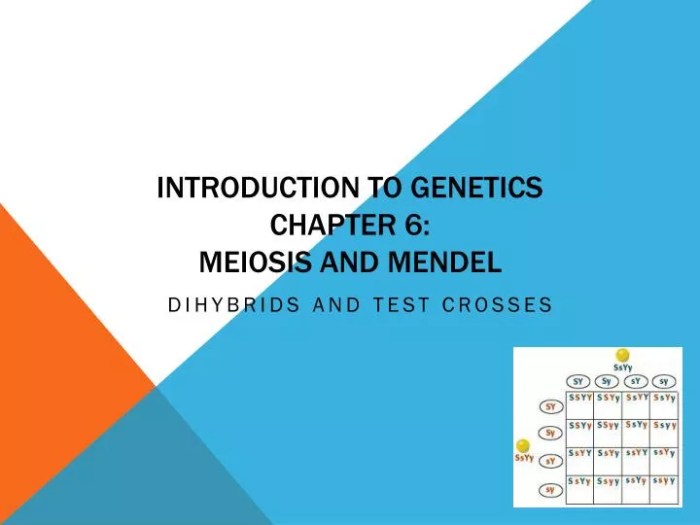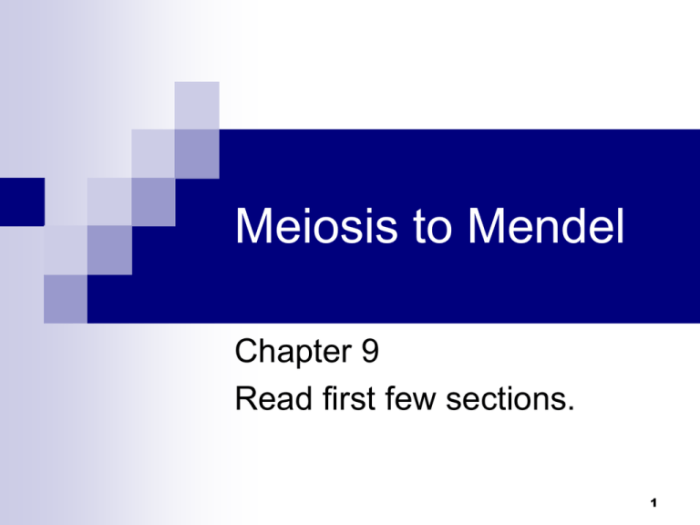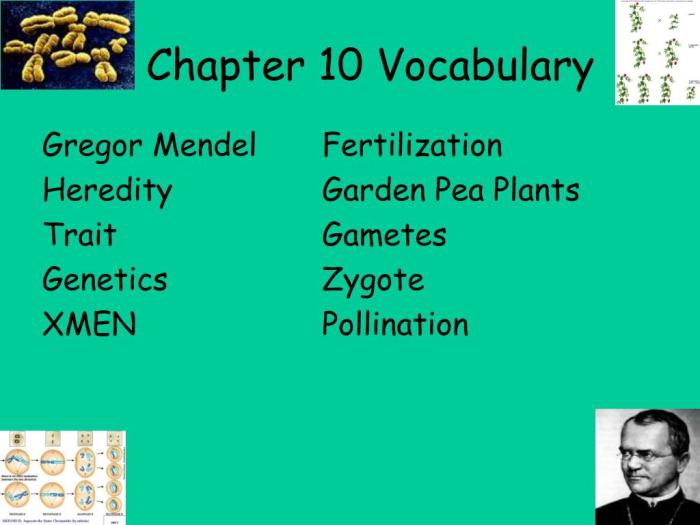Chapter 10 mendel and meiosis – Chapter 10: Mendel and Meiosis invites us on an enthralling journey into the captivating world of genetics. From Gregor Mendel’s pioneering experiments with pea plants to the intricate process of cell division, this chapter unravels the fundamental principles that govern the inheritance of traits.
Prepare to delve into the fascinating world of Mendelian genetics and meiosis, where the secrets of heredity are laid bare. Together, we’ll explore the concepts that shape the diversity of life on Earth and the profound implications they hold for medicine, agriculture, and biotechnology.
Introduction to Mendelian Genetics

Mendelian genetics, the foundation of modern genetics, unravels the fundamental principles of inheritance, the transmission of traits from parents to offspring. This chapter delves into the pioneering work of Gregor Mendel, who laid the groundwork for understanding the patterns of inheritance.
Gregor Mendel’s Experiments with Pea Plants
Mendel’s meticulous experiments with pea plants in the mid-19th century provided crucial insights into the laws of inheritance. He meticulously observed and recorded the transmission of seven distinct traits, such as seed color, seed shape, and plant height, across multiple generations.
Dominant and Recessive Alleles
Mendel’s experiments revealed that each trait is determined by a pair of alleles, alternative forms of a gene. One allele may be dominant, expressing its trait in the offspring even if only one copy is inherited. The other allele is recessive, only expressing its trait when two copies are inherited.
The combination of alleles inherited by an individual is known as its genotype, while the observable traits are its phenotype.
Meiosis: Chapter 10 Mendel And Meiosis

Meiosis is a specialized type of cell division that reduces the chromosome number by half, resulting in the formation of gametes (sex cells) such as sperm and eggs. This process ensures that each new organism has the correct number of chromosomes and maintains genetic diversity.
Stages of Meiosis
Meiosis consists of two successive divisions, known as meiosis I and meiosis II. Each division includes four distinct stages: prophase, metaphase, anaphase, and telophase.
Meiosis I
- Prophase I:Chromosomes condense and homologous chromosomes pair up, exchanging genetic material through a process called crossing over. This leads to genetic recombination and increased genetic diversity.
- Metaphase I:Homologous chromosome pairs line up at the equator of the cell.
- Anaphase I:Homologous chromosomes separate and move to opposite poles of the cell.
- Telophase I:Two daughter cells are formed, each with half the number of chromosomes as the parent cell.
Meiosis II
- Prophase II:Chromosomes condense again in the daughter cells.
- Metaphase II:Chromosomes line up at the equator of each daughter cell.
- Anaphase II:Sister chromatids of each chromosome separate and move to opposite poles of the daughter cells.
- Telophase II:Four haploid daughter cells are formed, each containing half the number of chromosomes as the original parent cell.
Role of Meiosis in Sexual Reproduction, Chapter 10 mendel and meiosis
Meiosis is crucial for sexual reproduction. It ensures that each gamete carries a unique combination of chromosomes, contributing to the genetic diversity of offspring. The fusion of two haploid gametes during fertilization restores the diploid chromosome number in the zygote, creating a new individual with a unique genetic makeup.
Genetic Variation and Inheritance

Genetic variation is the presence of differences in DNA sequences between individuals. It is the raw material for evolution and allows populations to adapt to changing environments. Genetic variation arises from two main sources: mutations and meiosis.
Meiosis is the process by which sex cells (eggs and sperm) are produced. During meiosis, the chromosomes in a cell are randomly shuffled and recombined, resulting in new combinations of alleles. This process ensures that each sex cell contains a unique combination of chromosomes, which increases the genetic diversity of the offspring.
Genetic Mutations
Genetic mutations are changes in the DNA sequence of an organism. Mutations can be caused by a variety of factors, including environmental toxins, radiation, and errors during DNA replication. Mutations can be harmful, beneficial, or neutral.
Harmful mutations are those that disrupt the function of a gene. These mutations can lead to genetic disorders, such as sickle cell anemia and cystic fibrosis. Beneficial mutations are those that improve the function of a gene. These mutations can give an organism an advantage in its environment, such as increased resistance to disease or improved reproductive success.
Chapter 10: Mendel and Meiosis delves into the fascinating world of genetics. To enhance your understanding of this topic, check out Wordly Wise Book 6 Lesson 11 . This resource provides valuable insights into vocabulary and usage related to genetics, further enriching your knowledge of Mendel and meiosis.
Inheritance of Genetic Variation
Genetic variation is inherited from parents to offspring through the process of sexual reproduction. When two parents mate, each parent contributes one set of chromosomes to their offspring. The offspring inherits a random combination of chromosomes from each parent, resulting in a unique genetic makeup.
The inheritance of genetic variation is essential for the survival of a species. It allows populations to adapt to changing environments and ensures that each individual has a unique set of traits.
Applications of Mendelian Genetics and Meiosis

Mendelian genetics and meiosis are fundamental concepts in biology with wide-ranging applications in various fields. From medicine and agriculture to biotechnology, these principles play a crucial role in understanding and manipulating genetic information.
Medicine
- Genetic Diagnosis:Mendelian genetics helps identify genetic disorders and predict the risk of inheriting them. By analyzing family pedigrees and genetic testing, healthcare professionals can diagnose conditions like cystic fibrosis, sickle cell anemia, and Huntington’s disease.
- Personalized Medicine:Meiosis and genetic variation contribute to individual responses to drugs and treatments. Pharmacogenomics uses genetic information to tailor drug dosage and therapy to optimize patient outcomes.
- Gene Therapy:Meiosis is essential for the production of gametes (eggs and sperm). Gene therapy involves manipulating the genetic material of these gametes to correct genetic defects or introduce new therapeutic genes.
Agriculture
- Crop Improvement:Mendelian genetics and meiosis enable plant breeders to develop new crop varieties with desirable traits, such as resistance to pests, diseases, and environmental stresses. By crossing different plant varieties and selecting for specific genetic combinations, farmers can improve crop yield and quality.
- Animal Breeding:Similar principles are applied in animal breeding to enhance livestock traits, such as growth rate, meat quality, and disease resistance. Artificial insemination and selective breeding techniques utilize genetic principles to improve animal production.
Biotechnology
- Genetic Engineering:Meiosis and genetic variation are essential for creating genetically modified organisms (GMOs). By manipulating genes and introducing them into organisms, scientists can create new traits and improve existing ones, leading to advancements in medicine, agriculture, and industrial applications.
- DNA Fingerprinting:Mendelian genetics and meiosis form the basis of DNA fingerprinting, a technique used in forensic science, paternity testing, and population genetics. By analyzing the unique genetic patterns inherited from both parents, scientists can identify individuals and establish genetic relationships.
Ethical Implications
The applications of Mendelian genetics and meiosis raise ethical concerns regarding the use and misuse of genetic information. Issues such as genetic discrimination, privacy, and the potential for eugenics need to be carefully considered and addressed.
Future Applications
Mendelian genetics and meiosis continue to drive advancements in various fields. Future applications may include personalized medicine based on individual genetic profiles, genetic engineering for disease prevention and treatment, and the development of synthetic biology for novel applications.
Essential FAQs
What are the key principles of Mendelian inheritance?
Mendelian inheritance, named after Gregor Mendel, describes the fundamental principles that govern the transmission of traits from parents to offspring. These principles include the law of segregation, the law of independent assortment, and the law of dominance.
What is meiosis, and how does it contribute to genetic variation?
Meiosis is a specialized cell division process that occurs in reproductive cells (eggs and sperm) and plays a crucial role in genetic variation. During meiosis, homologous chromosomes pair up and exchange genetic material, resulting in the production of gametes (eggs or sperm) that contain a unique combination of alleles.
How is genetic variation inherited from parents to offspring?
Genetic variation is inherited through the random combination of alleles from both parents during sexual reproduction. Each parent contributes one allele for each gene, and the offspring inherits two alleles, one from each parent. This process results in a wide range of genetic diversity within a population.